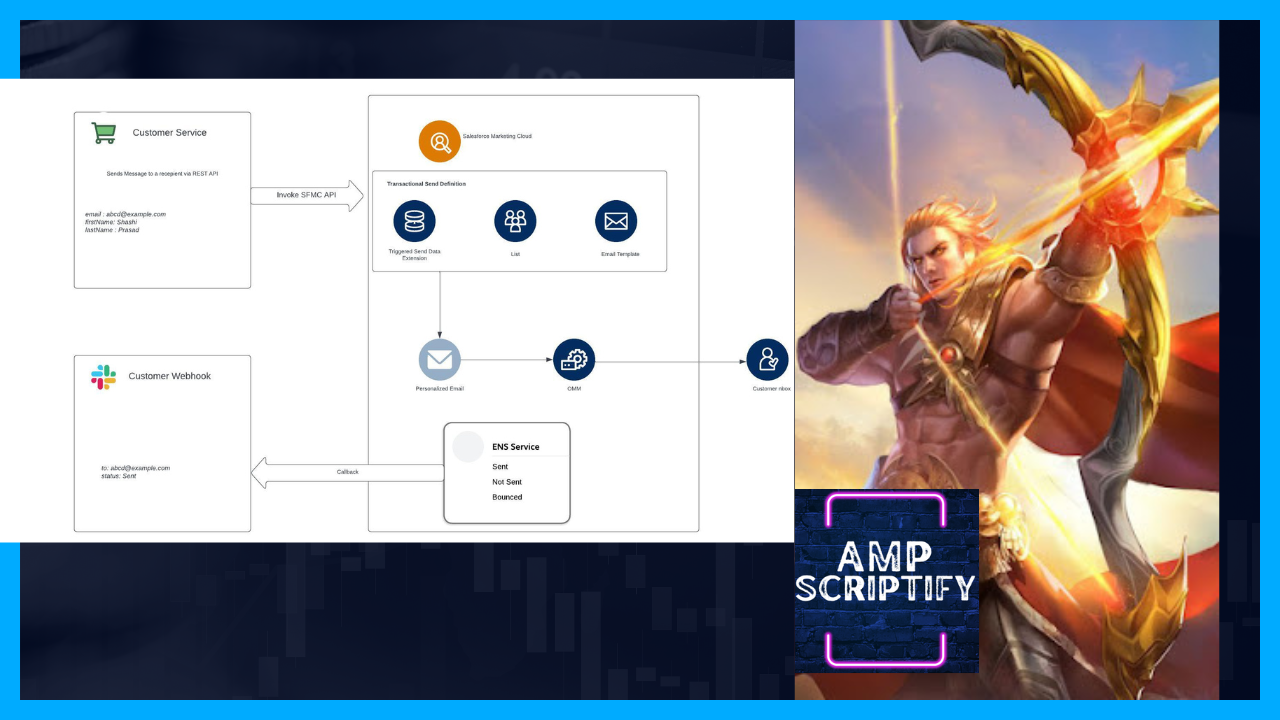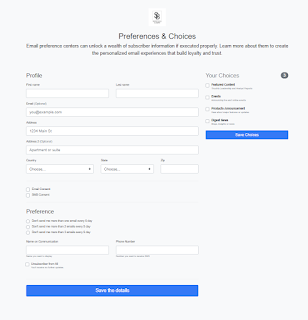Server-Side JavaScript (SSJS) Platform Functions
<script runat="server">
/*
* Script Author: Shashi Prasad
* Date: 10th Dec, 2024
* Description: This script demonstrates the use of GetAttributeValue to retrieve values
* from different attributes or fields for a recipient in Marketing Cloud.
*/
// GetAttributeValue: Returns the value from a specified attribute or sendable data extension field.
// Profile attribute email address
var contactEmail = Platform.Recipient.GetAttributeValue('EmailAddr');
Platform.Response.Write("Contact Email: " + contactEmail + '<br/>');
// Sendable data extension attribute
var subscriberkey = Platform.Recipient.GetAttributeValue('UID');
Platform.Response.Write("Subscriber Key: " + subscriberkey + '<br/>');
// MID
var memberId = Platform.Recipient.GetAttributeValue('memberid');
Platform.Response.Write("Member ID: " + memberId + '<br/>');
// BU Name
var busName = Platform.Recipient.GetAttributeValue('Member_Busname');
Platform.Response.Write("Business Name: " + busName + '<br/>');
// Subscriber Key
var subscriberKey = Platform.Recipient.GetAttributeValue('_subscriberkey');
Platform.Response.Write("Subscriber Key: " + subscriberKey + '<br/>');
// Job Id
var jobId = Platform.Recipient.GetAttributeValue('jobid');
Platform.Response.Write("Job ID: " + jobId + '<br/>');
</script>
<script runat="server">
/*
* Script Author: [Your Name]
* Date: [Current Date]
* Description: This script deletes rows from a specified Data Extension where the specified
* column values match the given criteria.
*/
// Define the Data Extension name
var deName = "Dataview_Bounce";
// Define the column names and values to match for deletion
var columnNames = ["SMTPCode"];
var columnValues = [550];
// Delete rows from the Data Extension
var rows = Platform.Function.DeleteData(deName, columnNames, columnValues);
// Output the result
Platform.Response.Write("Rows Deleted: " + rows);
</script>
<script runat="server">
/*
* Script Author: [Your Name]
* Date: [Current Date]
* Description: This script inserts data into a specified Data Extension with the provided column names
* and values.
*/
// Define the Data Extension name
var deName = "Dataview_Sent";
// Define the column names and values for insertion
var columnNames = ["JobID", "ListID", "BatchID", "SubscriberID", "SubscriberKey", "EventDate"];
var columnValues = [12345, 12345, 12345, 1234567890, "shashi@gmail.com", "11/29/2023"];
// Insert rows into the Data Extension
var rows = Platform.Function.InsertData(deName, columnNames, columnValues);
// Output the result
Platform.Response.Write("Rows Inserted: " + rows);
</script>
<script runat="server">
/*
* Script Author: [Your Name]
* Date: [Current Date]
* Description: This script looks up a SubscriberKey in a specified Data Extension based on
* the provided column names and values.
*/
// Define the Data Extension name
var deName = "Dataview_Bounce";
// Define the column names and values for the lookup
var columnNames = ["IsUnique", "BounceCategory"];
var columnValues = [1, "Hard bounce"];
// Lookup SubscriberKey in the Data Extension
var subscriberKey = Platform.Function.Lookup(deName, 'SubscriberKey', columnNames, columnValues);
// Output the result
Platform.Response.Write("SubscriberKey: " + subscriberKey);
</script>
<script runat="server">
/*
* Script Author: [Your Name]
* Date: [Current Date]
* Description: This script looks up rows in a specified Data Extension based on
* the provided column names and values.
*/
// Define the Data Extension name
var deName = "Dataview_Bounce";
// Define the number of rows to return
var numRows = 0; // Change this value as needed
// Define the column and direction to sort by
var sortOrder = 'SubscriberKey ASC'; // Change this value as needed
// Define the column names for the lookup
var columnNames = ["IsUnique", "BounceCategory"];
// Define the values to look up in the specified columns
var columnValues = [1, "Hard bounce"];
// Lookup rows in the Data Extension
var dataRows = Platform.Function.LookupOrderedRows(deName, numRows, sortOrder, columnNames, columnValues);
// Output the result
if(dataRows && dataRows.length > 0) {
for(var i=0; i<dataRows.length; i++) {
Platform.Response.Write("SubscriberKey: " + dataRows[i]["SubscriberKey"] + "<br/>");
Platform.Response.Write("EventDate: " + dataRows[i]["EventDate"] + "<br/>");
Platform.Response.Write("============================================= <br/>");
}
}
</script>
<script runat="server">
/*
* Script Author: [Your Name]
* Date: [Current Date]
* Description: This script looks up rows in a specified Data Extension based on
* the provided column names and values.
*/
// Define the Data Extension name
var deName = "Dataview_Bounce";
// Define the column names for the lookup
var columnNames = ["IsUnique", "BounceCategory"];
// Define the values to look up in the specified columns
var columnValues = [1, "Hard bounce"];
// Lookup rows in the Data Extension
var dataRows = Platform.Function.LookupRows(deName,columnNames,columnValues);
// Output the result
if(dataRows && dataRows.length > 0) {
for(var i=0; i<dataRows.length; i++) {
Platform.Response.Write("SubscriberKey: " + dataRows[i]["SubscriberKey"] + "<br/>");
Platform.Response.Write("EventDate: " + dataRows[i]["EventDate"] + "<br/>");
Platform.Response.Write("============================================= <br/>");
}
}
</script>
<script runat="server">
/*
* Script Author: [Your Name]
* Date: [Current Date]
* Description: This script updates rows in a specified Data Extension based on
* the provided column filter names and values.
*/
// Define the Data Extension name
var deName = "Dataview_Bounce";
// Define the column names and values for the filter
var columnFilterNames = ["IsUnique", "BounceCategory"];
var columnFilterValues = [1, "Hard bounce"];
// Define the column names and values for the update
var columnUpdateNames = ["JobID", "ListID"];
var columnUpdateValues = [12345, 12345];
// Update rows in the Data Extension
var rowsUpdated = Platform.Function.UpdateData(deName,columnFilterNames, columnFilterValues,columnUpdateNames, columnUpdateValues);
// Output the result
Platform.Response.Write("Rows Updated: " + rowsUpdated);
</script>
<script runat="server">
/*
* Script Author: [Your Name]
* Date: [Current Date]
* Description: This script updates rows in a specified Data Extension based on
* the provided column filter names and values.
*/
// Define the Data Extension name
var deName = "Dataview_Bounce";
// Define the column names and values for the filter
var columnFilterNames = ["IsUnique", "BounceCategory"];
var columnFilterValues = [1, "Hard bounce"];
// Define the column names and values for the update
var columnUpdateNames = ["JobID", "ListID"];
var columnUpdateValues = [12345, 12345];
// Update rows in the Data Extension
var rowsUpdated = Platform.Function.UpsertData(deName,columnFilterNames, columnFilterValues,columnUpdateNames, columnUpdateValues);
// Output the result
Platform.Response.Write("Rows Updated: " + rowsUpdated);
</script>
<script runat="server">
/*
* Script Author: [Your Name]
* Date: [Current Date]
* Description: This script demonstrates the usage of Now, SystemDateToLocalDate, and LocalDateToSystemDate functions.
*/
// Get the current system time
var time = new Date();
// Convert system time to local time
var localTime = Platform.Function.SystemDateToLocalDate(time);
// Convert local time back to system time
var systemTime = Platform.Function.LocalDateToSystemDate(time);
// Output the result
Platform.Response.Write("Time: " + time + "\n");
Platform.Response.Write("Local Time: " + localTime + "\n");
Platform.Response.Write("System Time: " + systemTime + "\n");
</script>
<script runat="server">
/*
* Script Author: [Your Name]
* Date: [Current Date]
* Description: This script demonstrates the usage of Base64Encode, Base64Decode, GUID, IsEmailAddress, IsPhoneNumber, and MD5 functions.
*/
// Define a normal string
var normalStr = "Shashi";
// Encode the string to Base64
var encodedStr = Platform.Function.Base64Encode(normalStr);
// Decode the Base64-encoded string
var decodedStr = Platform.Function.Base64Decode(encodedStr);
// Generate a random GUID
var randomID = Platform.Function.GUID();
// Check if the email address is valid
var isEmailValid = Platform.Function.IsEmailAddress("shashi@example.com");
// Check if the phone number is valid
var isPhoneValid = Platform.Function.IsPhoneNumber("1234567890");
// Calculate MD5 hash of the string
var md5String = Platform.Function.MD5(normalStr, "UTF-8");
// Output the result
Platform.Response.Write("Normal String: " + normalStr + "\n");
Platform.Response.Write("Encoded: " + encodedStr + "\n");
Platform.Response.Write("Decoded: " + decodedStr + "\n");
Platform.Response.Write("Random ID: " + randomID + "\n");
Platform.Response.Write("Is Email Valid: " + isEmailValid + "\n");
Platform.Response.Write("Is Phone Valid: " + isPhoneValid + "\n");
Platform.Response.Write("MD5 Hash: " + md5String + "\n");
</script>
<script runat="server">
// Load the Core library with version 1.1.1
Platform.Load("Core", "1.1.1");
// Your payload as a JSON string
var payloadString = '[{"Prod_ID": 1, "Prod_Name": "Nike", "Prod_Desc": "Shoe"}, {"Prod_ID": 5, "Prod_Name": "Puma", "Prod_Desc": "Slipper"}, {"Prod_ID": 10, "Prod_Name": "Adidas", "Prod_Desc": "Jacket"}]';
// Parse the JSON string
var payload = Platform.Function.ParseJSON(payloadString);
// Check if parsing was successful
if (payload !== null) {
// Iterate through the payload array
for (var i = 0; i < payload.length; i++) {
var product = payload[i];
// Extract and print product details
var productId = product.Prod_ID;
var productName = product.Prod_Name;
var productDescription = product.Prod_Desc;
// Output the parsed values
Platform.Response.Write("Product ID: " + productId + "<br>");
Platform.Response.Write("Product Name: " + productName + "<br>");
Platform.Response.Write("Product Description: " + productDescription + "<br>");
Platform.Response.Write("-------------------------<br>");
}
} else {
// Output message if parsing failed
Platform.Response.Write("Failed to parse JSON.");
}
</script>
<script runat="server">
/*
* Script Author: [Your Name]
* Date: [Current Date]
* Description: This script demonstrates the usage of various Platform.Request functions in Marketing Cloud scripting.
*/
// Check if the request is made over SSL
var IsSSL = Platform.Request.IsSSL;
// Check if the request has SSL
var HasSSL = Platform.Request.HasSSL;
// Get the client's IP address
var ClientIP = Platform.Request.ClientIP;
// Get the request method (e.g., GET or POST)
var Method = Platform.Request.Method;
// Get the query string parameters
var QueryString = Platform.Request.QueryString;
// Get the referring URL
var ReferrerURL = Platform.Request.ReferrerURL;
// Get the current request URL
var RequestURL = Platform.Request.RequestURL;
// Get the user agent string
var UserAgent = Platform.Request.UserAgent;
// Get information about the browser
var Browser = Platform.Request.Browser;
// Output the result
Platform.Response.Write("IsSSL: " + IsSSL + "\n");
Platform.Response.Write("HasSSL: " + HasSSL + "\n");
Platform.Response.Write("ClientIP: " + ClientIP + "\n");
Platform.Response.Write("Method: " + Method + "\n");
//Platform.Response.Write("QueryString: " + QueryString + "\n");
//Platform.Response.Write("ReferrerURL: " + ReferrerURL + "\n");
// Platform.Response.Write("RequestURL: " + RequestURL + "\n");
// Platform.Response.Write("UserAgent: " + UserAgent + "\n");
// Platform.Response.Write("Browser: " + Stringify(Browser) + "\n");
</script>








Comments
Post a Comment